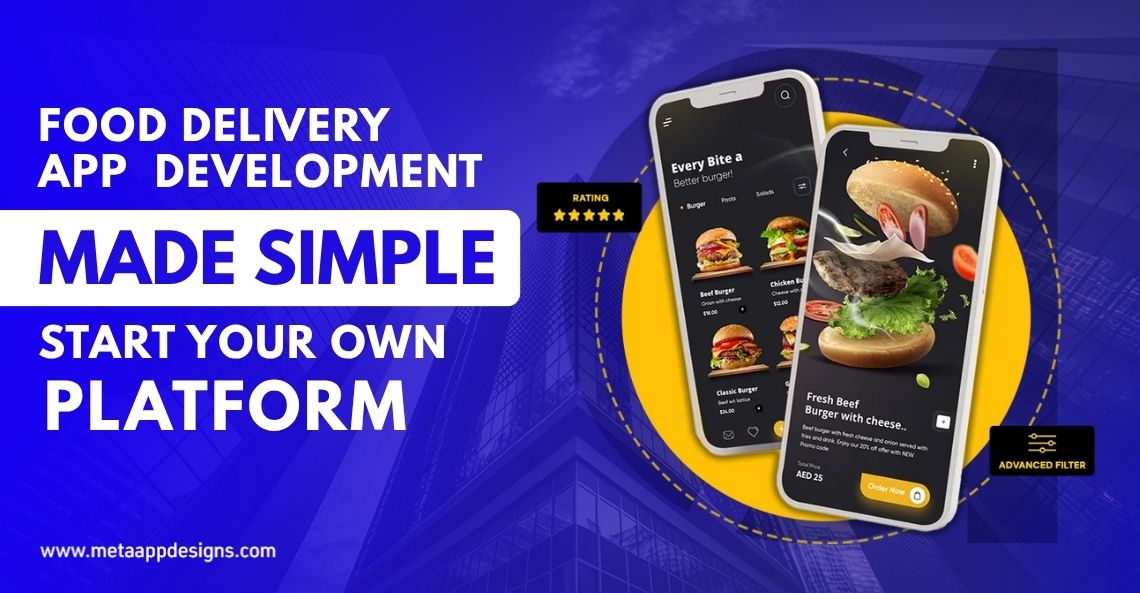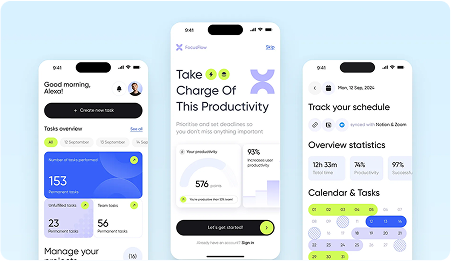
Food Delivery App Development Made Simple: Start Your Own Platform
A successful Food Delivery App development starts with tight planning and simple execution. This guide explains how to scope, build, launch, and grow using proven methods. The approach reflects deliveries shipped by Meta App Designs for marketplaces and local brands.
Thank you for reading this post, don't forget to subscribe!Who this guide is for
Founders, product managers, and operations teams will find practical steps here. Restaurant groups and cloud kitchens planning a direct channel can use this as a roadmap. Teams with a v1 can use it to audit gaps and improve reliability.
Market snapshot and why it matters
Table Of Content
Food delivery became a global market above $150 billion by 2021, more than tripling since 2017. Demand remains strong, and usage shifted from niche to habit across key regions.
Delivery speed shapes satisfaction. A 2024 benchmark of 600 U.S. orders showed a 33:24 average, with DoorDash at 26:24, faster than peers. Faster services correlate with better repeat rates.
Snapshot Table: Market Signals
| Topic | Data Point | |
| Global size | $150B+ by 2021, tripled since 2017 | |
| Avg U.S. delivery time | ~33 minutes overall | |
| Fastest platform in study | DoorDash 26:24 |
Why build your own platform
Owning your platform means owning customer data, pricing, and experience. You can design features for your niche, control fees, and create durable margins. You also reduce reliance on third-party algorithms and shifting marketplace policies.
Business models to consider
Single-restaurant delivery fits chains seeking direct control and loyalty. Multi-vendor marketplaces cover a city or cuisine niche with network effects. Cloud kitchens drive tighter unit economics and rapid menu tests. Pick one for MVP to avoid scope creep.
Core user roles and surfaces
You need four surfaces: a customer app or web app, a restaurant portal, a courier app, and an operator console. Each role has distinct tasks. Mixing roles into one UI wastes time and creates errors during peak hours.
Table: Surfaces and Primary Goals
| Surface | Main User | Primary Goal | Must-Have |
| Customer app/web | Buyer | Fast browse to checkout | Accurate ETAs, clear fees |
| Restaurant portal | Merchant | Menu and order control | Prep times, stock flags |
| Courier app | Driver | Efficient routing | Navigation, proof of delivery |
| Operator console | Support/Ops | Live routing and refunds | Escalation tools, SLAs |
Customer app essentials
Onboarding should be quick with precise address capture and saved places. Discovery should allow cuisine, diet, and price filters. The cart must show all fees early to build trust. Payments should include popular local methods, saved cards, and tipping.
Restaurant portal essentials
Menus need real-time price and stock control. Orders should appear in a queue with prep-time tools and delay buttons. Merchants must see payouts, fees, taxes, and disputes in one place. Promotions and bundles should be simple to launch and measure.
Courier app essentials
Couriers need clean flows to go online, accept tasks, and batch efficiently. Turn-by-turn navigation with traffic hints reduces delays. Proof of delivery with notes or photos avoids disputes. Earnings, bonuses, and payout timelines must be transparent.
Table: Feature Priorities by Role
| Role | Top 3 Priorities | Why it matters |
| Customer | Fees early, fast checkout, live ETA | Lifts conversion and trust |
| Merchant | Stock flags, prep times, payouts view | Cuts cancellations and churn |
| Courier | Simple batching, navigation, earnings | Improves on-time rate |
| Ops | Map, reassignment, refunds | Protects NPS and margin |
Revenue model basics
Most platforms blend commissions, delivery fees, and service fees. Commission bands of roughly 15% to 30% are common among major U.S. platforms, with extra service fees in the 2% to 4% range. Model these with buffers to protect contribution margin.
Subscriptions and ads
Subscriptions can lift repeat orders among heavy users. Sponsored listings and in-app ads now drive meaningful revenue, with self-serve ad tools common across top platforms. Keep ad exposure capped to preserve trust.
Who orders most often
Younger and urban users order more frequently. YouGov data shows weekly usage is materially higher among Gen Z and Millennials, with urban dwellers outpacing rural users. Plan early targeting and promotions around these cohorts.
Table: Monetization Levers
| Lever | When to use | Notes |
| Commissions | Launch | Start mid-band, test cohorts |
| Delivery fees | Launch | Tie to distance and demand |
| Subscriptions | Post-MVP | Add once retention is stable |
| Sponsored listings | Post-MVP | Cap exposure, track ROAS |
MVP scope that ships
Launch in one city with tight zones and a curated merchant set. Start with essential payment methods and add wallets after stability improves. Keep the feature list small so you can learn quickly. Scale after meeting on-time and repeat-rate targets.
Operations you can trust
Standardize prep times by cuisine and update from real data. Calibrate ETAs to local speeds and weather. Balance zones to match expected courier supply. Reassign quickly when kitchen delays appear. Close the loop on refunds within clear, simple rules.

Architecture overview
Split services for orders, menus, users, payments, and dispatch. Keep dispatch logic separate to upgrade batching later without breaking checkout. Use queues for events and retries to absorb spikes. Cache hot menus and category pages. Log every order state change end to end.
Table: MVP Scope Checklist
| Area | Start with | Add later |
| Payments | Cards + one local method | Wallets, BNPL |
| Discovery | Cuisine, diet, price | Personalization |
| Logistics | Simple batching | ML-assisted routing |
| Promotions | First-order coupon | Tiered loyalty |
Tech stack choices
React Native or Flutter cover mobile with one codebase. React or Next.js suits web speed and SEO control. Node, Python, or Go each work for backends; choose what your team ships fastest. PostgreSQL stores core records. Redis handles caching, queues, and rate limits.
Maps, routing, and ETA accuracy
Use a mature maps SDK with live traffic and reliable geocoding. Batch orders by distance, prep time, and driver proximity. Keep the first version simple and measurable. Improve after enough real-trip data arrives. Better ETAs reduce support volume and churn.
Payments, refunds, and payouts
Offer cards and popular local methods first. Support tips at checkout and after delivery. Handle partial and full refunds cleanly with audit trails. Automate merchant payouts and reconciliation. Keep tokens encrypted with least-privilege access policies for compliance.
Table: Core Tech Picks
| Layer | Recommended Options | Why |
| Mobile | React Native or Flutter | Speed to ship |
| Web | React or Next.js | SEO + performance |
| Backend | Node, Python, or Go | Team familiarity |
| Data | PostgreSQL + Redis | Reliability + speed |
| Maps | Commercial SDK with traffic | ETA accuracy |
Notifications that help
Use push for order state and ETA changes. Use SMS for critical steps like arrival or payment issues. Let users adjust frequency and channel. Bundle low-priority updates to avoid spam. Good messaging reduces tickets and increases trust.
Analytics and KPIs
Track orders, AOV, CAC, and repeat rate by cohort. Track late deliveries by hour and weather to find patterns. Track cancellations by reason codes like stockouts or courier delays. Track courier acceptance and online hours. Convert insights into weekly actions.
Trust, safety, and compliance
Follow local tax, invoicing, and e-receipt rules. Limit personal data access with roles and logs. Publish a privacy policy that matches operations. Review retention schedules and test deletions. Many service-quality studies link speed and accuracy to repurchase intent.
Table: KPI Targets (Example)
| Metric | Early Target | Why it matters |
| On-time deliveries | ≥ 85% | Cuts refunds |
| Repeat rate (30-day) | ≥ 35% | Cohort health |
| Avg delivery time | ≤ 35 min | Satisfaction driver |
| Refund resolution time | ≤ 24 hrs | Retention impact |
Security checklist you can follow
Use HTTPS with HSTS across apps and APIs. Rotate keys and secrets on a calendar. Rate-limit by user and IP. Encrypt tokens and sensitive fields at rest and in backups. Run dependency scans, patch quickly, and write change notes.
UX rules that lift conversion
Reduce taps to checkout using saved details. Show all fees before the last step. Explain delays and stockouts in clear language with alternatives. Keep support visible in sensitive steps. Use real photos and consistent naming across menus.
Growth loops that compound
Offer a first-order coupon with strict caps. Use refer-a-friend rewards that pay on completed deliveries. Promote lunch and dinner bundles to lift basket size. Send lifecycle emails with useful suggestions. Focus on profitable cohorts, not vanity volume.
Table: Growth Experiments
| Experiment | Goal | Guardrail |
| First-order coupon | Convert new users | CAC payback |
| Referral reward | Acquire similar users | Fraud checks |
| Meal bundles | Raise AOV | Margin floor |
| Win-back email | Reactivate sleepers | Unsubscribe rate |
Restaurant onboarding steps that work
Use a short contract with clear fees and payout timing. Provide a menu template, photo tips, and a simple portal guide. Set prep-time guidelines and show why accuracy matters. Offer a small launch promotion. Review performance with each merchant after week one.
Courier supply that stays stable
Recruit locally with clear earnings and zones. Keep onboarding fast and well documented. Provide in food delivery app development support during live orders with target response times. Reward reliability with predictable bonuses. Low churn protects SLAs and keeps ETAs stable.
Reliability and observability
Add health checks to every service and queue. Configure alerts that point to likely root causes. Make order flows idempotent with retries and deduplication. Keep dashboards simple for on-call teams. Practice recovery so incidents resolve quickly and cleanly.
Table: Ops Playbook
| Area | Practice | Frequency |
| Prep-time tuning | Update by cuisine | Weekly |
| ETA calibration | Compare vs actuals | Weekly |
| Incident review | Postmortem with fixes | Bi-weekly |
| Refund audits | Random sample review | Weekly |
Performance and scale tactics
Optimize menu queries and compress images. Lazy load heavy assets and paginate long lists. Cache popular lists and home feeds near users. Monitor p95 and p99 latency per screen and set budgets. Schedule performance work each sprint, not only after incidents.
Personalization that feels helpful
Recommend items by time of day, location, and past orders. Respect contribution margin so suggestions remain profitable. Test changes on small cohorts with clear success metrics. Roll back quickly when metrics slip. Explain choices in simple language.
Industry moves to watch
Consolidation continues across regions as large players expand by acquisition and new services. Following these moves helps you anticipate standards for logistics and ads. Recent transactions show expansion across Europe, Asia, and the Middle East.
Table: External Signals
| Signal | Example | Why it matters |
| Consolidation | DoorDash–Deliveroo deal | Raises bar on ops |
| Grocery tie-ins | Same-day push trends | Expands use cases |
| Regulation | Oversight in big markets | Cost, policy shifts |
Choosing a build partner
Work with an on-demand food delivery app development company that has shipped live MVPs you can audit. Ask for references, uptime records, and incident write-ups. Review CI, QA, and rollback practices. A reliable partner makes scaling easier and safer.
Why teams buy services
Expert teams shorten time to market and reduce rework. They bring tested tooling, mature processes, and realistic vendor choices. They align product with daily operations from day one. That is the value of strong food delivery app development services.

What to expect from a vendor
Expect short sprints, weekly demos, and clear acceptance criteria. Expect staged rollouts and safe migrations. Expect structured logs, alerts, and dashboards. Expect coaching for merchants and couriers. Great food delivery app developers plan for scale without bloat.
Table: Vendor Checklist
| Item | What to verify | Red flag |
| Live apps | Download and test | Slides only |
| CI/QA | Pipelines, coverage | Manual releases |
| Observability | Dashboards, alerts | Sparse logs |
| Support | SLAs, runbooks | Ad-hoc fixes |
Role of your brand and Meta App Designs
Meta App Designs translates business goals into shipped features and measurable outcomes. We help with discovery, product design, delivery, and audits. We focus on reliability, payments, dispatch, and analytics to improve unit economics and customer trust.
Practical roadmap after MVP
Group orders can unlock office demand. Loyalty tiers can lift retention when discounts decline. Express menus for best sellers reduce choice overload. Merchant ads can add revenue once cohorts are healthy. Add features only after core flows prove stable.
Comparison and planning table
| Area | Goal | Owner | Success Metric | Tools | Notes |
| Customer App | Fast browse and checkout | Product | Checkout conversion | Analytics, A/B | Show fees early and save addresses |
| Restaurant Portal | Accurate menus and prep | Merchant Ops | On-time prep rate | Portal, CSV | Delay tools reduce cancellations |
| Courier App | Efficient routing | Logistics | On-time delivery rate | Maps SDK, GPS | Fewer taps, clear earnings |
| Operator Console | Fast resolution | Support | First-contact resolution | CRM, dashboards | Guardrails for refunds |
| Payments | Reliable collection | Finance | Auth success rate | PSP, vault | Automate payouts |
| Notifications | Helpful updates | Marketing | Opt-in retention | Push, SMS | Bundle low-priority messages |
| Reliability | Fewer incidents | Engineering | Uptime, MTTR | Alerts, runbooks | Test recovery |
| Performance | Fast loads | Engineering | p95 latency | CDN, caching | Paginate and lazy load |
| Growth | Profitable cohorts | Growth | CAC payback | Coupons, referrals | Margin floors |
| Compliance | Real policies | Legal | Audit readiness | DLP, logs | Least-privilege access |
Conclusion
Winning teams focus on simple scope, fast feedback, and steady improvement. They launch small, tune operations weekly, and protect contribution margin. A clear plan beats guesswork. With stable core flows, expansion becomes a repeatable play, not a risky leap.
Frequently Asked Questions
Launch in one city with tight zones and a curated merchant set. Keep features lean. Measure SLAs weekly. Expand once on-time delivery and repeat rate hold.
Discovery often takes one to two weeks. Build usually takes three to four months. A pilot runs four to six weeks. Scope and team size shape the timeline.
Blend commissions, delivery fees, and service fees. Add subscriptions or ads after cohorts stabilize. Commission ranges near 15% to 30% are common in the U.S.
Tune ETAs with local data. Batch by prep time and distance. Balance zones by supply. Escalate delays early and reassign quickly. Benchmarks show faster brands keep stronger loyalty.
Younger and urban users order more often. Plan early promotions and partnerships around these cohorts to reach repeat behavior faster.
- Food App Developors
- Food Delivery App Development
- Food Delivery App Development Services
- Food Ordering App Development Company
Table Of Content






